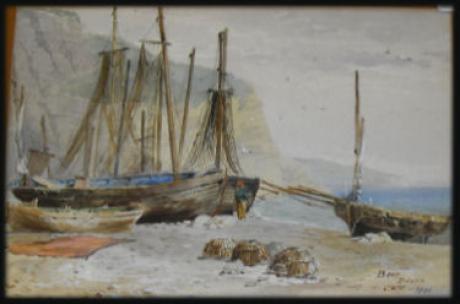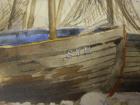initialled, titled and dated "1896" bottom right
Beer is mentioned in the Domesday Book of 1086, at which time it was located within Colyton hundred and had 28 households. Its name is not derived from the drink, but from the Old English word bearu, meaning "grove" and referring to the original forestation that surrounded the village.
It is a pretty coastal village that grew up around a smugglers' cove and caves which were once used to store contraband goods. These are now part of the attraction of the village. Many of the buildings are faced with flint, a hard glassy stone found in the local chalk rock.
Beer grew up around a smuggler’s cove and the caves, which still characterize this picturesque town on Lyme Bay. The men of Beer were once known as the 'the very kings of smugglers' and the caves were used to store all kinds of contraband. However, surprisingly, the town does not take its name from the barrels of the good stuff that would have inevitably been stored in these aforementioned hidey holes. Beer is an Anglo-Saxon word and refers to the forests which used to surround this particular hamlet. The smuggling history is very much reflected in the town today and Jack Rattenbury is notorious as the most famous smuggler in the South West.
Historically, the main sources of income for the village include fishing and lace production.Boats are winched up the beach as there is no harbour, and fresh fish is sold nearby. Nowadays small electrically driven winches using steel cables or tractors are located on the beach to haul boats in. Higher up is an old manual capstan operated by up to 20 men, now disused. A brook winds its way in an open conduit alongside the main road down to the sea. A WW2 pillbox is located close to the western side of the beach exit.
The shape of the coastline allowed local seafarers to operate in weather conditions when other towns could not, because it is protected from the prevailing westerly winds by Beer Head and the chalk cliffs which are the furthest outcrop of limestone on the southwest coast.
Beer has a steep pebble beach. This makes walking on the beach difficult. Long rubber mats — actually recycled conveyor belts — are laid down to assist walkers. Beer is home to a cave complex, the Beer Quarry Caves, resulting from the quarrying of Beer stone. This stone has been prized since Roman times, because of its workability for carving and for its gentle yellow colour on exposure to air. Beer stone was used in the construction of 24 cathedrals[citation needed] around the UK, including Exeter Cathedral, Westminster Abbey and St. Paul's Cathedral, and was also used in the building of Christchurch Cathedral, St.Louis. Missouri, USA. Bovey House, an Elizabethan manor house, is a mile inland. The enormous Beer Quarry Caves produce this stone which has been used in the construction of many cathedrals throughout the UK and the world. Notorious for its unique workability for carving and its colouring on exposure to air, it can be seen locally and at such iconic buildings as Westminster Abbey, St Paul’s Cathedral and as far away as Christchurch Cathedral in New York. Even Buckingham Palace has taken advantage of this particular product of Beer.
The Manor dates back to 1122 and Henry VIII included it in the dowry of Catherine Parr. Tradition has it that neighboring villages jokingly refer to Beer's inhabitants as Spaniards, due to the fact a Spanish vessel, possibly of the Armada, was wrecked nearby and the survivors settled in the sparsely populated town which had been ravaged by the plague.
Starre House, the oldest house in Beer is built using the local Beer stone that has been quarried since Roman times.
Bacteria taken from cliffs at Beer on the south coast were launched to the International Space Station in 2008.The Beer microbes were placed on the European Space Agency's (ESA) Technology Exposure Facility and were sent up still sitting on, and in, small chunks of cliff rock from the Jurassic Coast. After 553-days they found that many were still alive. The survivors are now reproducing in a laboratory. This was part of an experiment to study the survival of microbes (which naturally live on the stone) in extreme conditions. A new species of cyanobacteria was isolated at the Open University that could be used in future space settlements on the Moon and Mars to produce oxygen and break down rocks.
Noteable People:
William George Aston (1841–1911) died in Beer.
Richard Gush (1789–1858) was born in Beer.
Rowland Molony (born 1946) lives in Beer.
Charles William Peach (1800–1886) lived in Beer.
Jack Rattenbury was born in Beer.
William Henry Woodgate (1827–1877), born in Beer
William Ashton Oswald (born 1995), resides in Beer when not promoting 'Papped'
George Marks painted landscapes with idealised titles: Autumn Glow, A Gleam of Sunshine, Rose Garden and The Rhododendron Walk. He was born in Long Row, Lanarkshire, Scotland and He lived in Penge and later in Shere near Guildford, and painted mainly in Kent, Surrey and Sussex. Marks exhibited at the Royal Academy between 1878 and 1930. He was a most admired watercolourist who exhibited at the Royal Academy, Royal Watercolour Society, New Watercolour Society and elsewhere. He died on 26 Nov 1933 in Airdrie, Lanarkshire, Scotland.
Charles W Fothergill is known to have exhibited 3 watercolours at the SS 1880-1884 including "the Mouth of the Dart" and "Hulks in Portsmouth Harbour" with an address in London and Cranbrook Kent.



